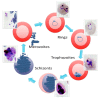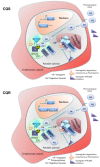Targeting Plasmodium falciparum Hsp90: Towards Reversing Antimalarial Resistance
- PMID: 25436880
- PMCID: PMC4235713
- DOI: 10.3390/pathogens2010033
Targeting Plasmodium falciparum Hsp90: Towards Reversing Antimalarial Resistance
Abstract
Malaria continues to exact a great human toll in tropical settings. Antimalarial resistance is rife and the parasite inexorably develops mechanisms to outwit our best drugs, including the now first-line choice, artesunate. Novel strategies to circumvent resistance are needed. Here we detail drug development focusing on heat shock protein 90 and its central role as a chaperone. A growing body of evidence supports the role for Hsp90 inhibitors as adjunctive drugs able to restore susceptibility to traditionally efficacious compounds like chloroquine.
Figures




Similar articles
-
Inhibitors of the Plasmodium falciparum Hsp90 towards Selective Antimalarial Drug Design: The Past, Present and Future.Cells. 2021 Oct 22;10(11):2849. doi: 10.3390/cells10112849. Cells. 2021. PMID: 34831072 Free PMC article. Review.
-
Identification and characterization of the antiplasmodial activity of Hsp90 inhibitors.Malar J. 2017 Jul 19;16(1):292. doi: 10.1186/s12936-017-1940-7. Malar J. 2017. PMID: 28724415 Free PMC article.
-
Plasmodium falciparum R2TP complex: driver of parasite Hsp90 function.Biophys Rev. 2019 Dec;11(6):1007-1015. doi: 10.1007/s12551-019-00605-3. Epub 2019 Nov 16. Biophys Rev. 2019. PMID: 31734827 Free PMC article. Review.
-
[In vitro susceptibility of P. falciparum isolates from Abidjan (Côte d'Ivoire) to quinine, artesunate and chloroquine].Sante. 2008 Jan-Mar;18(1):43-7. doi: 10.1684/san.2008.0103. Sante. 2008. PMID: 18684691 French.
-
Targeting heat shock protein 90 for malaria.Mini Rev Med Chem. 2013 Nov;13(13):1903-20. doi: 10.2174/13895575113136660094. Mini Rev Med Chem. 2013. PMID: 24070209 Review.
Cited by
-
Novel Harmicines with Improved Potency against Plasmodium.Molecules. 2020 Sep 23;25(19):4376. doi: 10.3390/molecules25194376. Molecules. 2020. PMID: 32977642 Free PMC article.
-
Hsp90 and Associated Co-Chaperones of the Malaria Parasite.Biomolecules. 2022 Jul 22;12(8):1018. doi: 10.3390/biom12081018. Biomolecules. 2022. PMID: 35892329 Free PMC article. Review.
-
Novobiocin-ferrocene conjugates possessing anticancer and antiplasmodial activity independent of HSP90 inhibition.J Biol Inorg Chem. 2019 Mar;24(2):139-149. doi: 10.1007/s00775-018-1634-9. Epub 2018 Dec 12. J Biol Inorg Chem. 2019. PMID: 30542925
-
Mutation of GGMP Repeat Segments of Plasmodium falciparum Hsp70-1 Compromises Chaperone Function and Hop Co-Chaperone Binding.Int J Mol Sci. 2021 Feb 23;22(4):2226. doi: 10.3390/ijms22042226. Int J Mol Sci. 2021. PMID: 33672387 Free PMC article.
-
A seven-year surveillance of epidemiology of malaria reveals travel and gender are the key drivers of dispersion of drug resistant genotypes in Kenya.PeerJ. 2020 Mar 12;8:e8082. doi: 10.7717/peerj.8082. eCollection 2020. PeerJ. 2020. PMID: 32201636 Free PMC article.
References
-
- Sherman I.W. The life of plasmodium: An overview. In: Sherman I.W., editor. Molecular approaches to malaria. ASM Press; Washington, D.C., USA: 2005. pp. 3–23.
Publication types
LinkOut - more resources
Full Text Sources
Other Literature Sources

